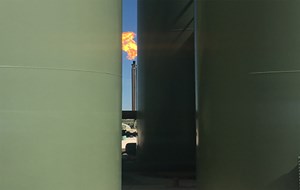eMission: Impossible?
Industry’s emphasis to control greenhouse gas (GHG) emissions became stronger this year, as a new line in the sand was drawn by the U.S. federal government with the release of the “Inflation Reduction Act of 2022.” Following behind the 2021 Environmental Protection Agency’s (EPA’s) “Regulations of Petroleum and Natural Gas Systems,” this new legislation establishes a charge on methane emissions from specific types of facilities that are required to report their GHG emissions to the EPA’s Greenhouse Gas Emissions Reporting Program. These include facilities associated with the onshore and offshore production, processing, transmission and compression of hydrocarbons and facilities associated with the storage, exporting, and importing of LNG.
The emission charge starts at $900 per metric ton of methane, increasing to $1,500 after two years, which equates to $36 and $60 per metric ton of carbon dioxide-equivalent, respectively. This is the first time the federal government has directly imposed a charge, fee, or tax on GHG emissions
Methane is recognized as the leading GHG contributor to global warming. While making up just 11% of GHG emissions when compared to 79% for CO2, methane’s global warming potential is 25 times that of an equivalent mass of CO2 during a 100-year period. For a 20-year period, methane’s warming potential is 72 times higher. Unlike CO2 where the combustion of fossil fuels accounts for 80% of this GHG emission, only 32% of total methane emissions is associated with O&G operations, Fig. 1.

The greatest source of methane is, however, not our industry, but agriculture, where domestic livestock and manure management account for 36% of this GHG. As methane is short-lived in the atmosphere, any additional curbing of these emissions can make a meaningful near-term impact on climate warming.
CO2. With the passing of the Inflation Reduction Act, Carbon Capture and CCS issues still dominated GHG industry headlines in 2022. The increase in 45-Q credits from $50/tonne to $85/tonne for storage in saline geologic formations has fueled explosive growth within the CCS industry.
As reported by Rystad Energy, spending on CCS is expected to quadruple from the $4.4 billion projected in 2022 to approximately $19 billion by 2025. Total spending for this period is projected at $52 billion. Out of the 84 announced CCUS projects globally, 62 are scheduled to start operations by 2025. With 56 CCS projects already in operation, these additional facilities will allow for the capturing of 150 million tonnes of CO2 globally per year by the end of 2025.
There are, however, lots of “CCS buts” involved, the biggest of which is the reliance on governmental incentives for these high-cost facilities to have the hope of becoming profitable. Technological advancements in CO2 collection and transportation will certainly reduce costs going forward, but the ultimate success of these planned facilities with be the continuance and growth of governmental incentives.
To achieve the goal of net zero greenhouse gas emissions by 2050, as set by the U.S., the EU, and most other countries, such support will certainly have to remain. Perhaps the greatest uncertainty and risk for the CCS industry domestically, and internationally as well, is how future administrations will view and support this net-zero 2050 goal and the continuation of incentive programs.
Methane leak detection. In their 2021 Regulations of Petroleum and Natural Gas Systems, the EPA established requirements associated with the detection and repair of methane leaks (LDAR). While guidance is given on acceptable detection methods to be used and the number of LDAR inspections to be performed each year, the EPA also wisely included the caveat that they would consider innovative solutions emerging from the rapid development of digital environmental monitoring technologies.
Digitalization of the oilfield continues to expand, as traditional labor-intensive leak detection methods are transitioning to emerging digital solutions, such as the use of thermal imaging by satellites and drones, which scan for methane leaks in areas ranging in size from entire basins down to selected fields or even individual facilities. While the ability of these digital technologies to detect and map existing leaks is truly impressive, they have limitations in providing real-time notification of early leaks, which would allow corrective steps to be taken before significant emissions occur.
Continuous monitoring solutions available from Digital Oilfield providers, such as ShowMyWell in Houston, utilize IoT architecture and fixed location sensors to provide this needed early notification. By leveraging the plug-and-play capabilities of IoT technology, ShowMyWell provides customized solutions that incorporate data collection, data analytics and visualization technologies to detect and track fugitive (unplanned) methane leaks on behalf of all stakeholders, including operators, investors, underwriters and landowners.
As a result of the high accuracy, scalability, and low cost of these systems, continuous digital monitoring solutions will certainly augment or replace some regulatory requirements with semi-annual or quarterly LDAR inspections. Industry’s growing demand for continuous emission monitoring is evidenced in bp’s January 2022 letter to the EPA concerning comments on planned regulations. It states, “bp believes continuous monitoring can provide a rapid, cost-competitive, and autonomous alert system to notify operators of potentially anomalous, unplanned, or fugitive emissions events. As an alert system, continuous monitors can trigger additional action to assess conditions and determine the appropriate course of action, including deployment of personnel for further investigation and repair.”
Conclusion. Companies that incorporate digital GHG detection technologies into their corporate digital strategies will now be able to optimize carbon management, in addition to accelerating decision-making and optimizing operations. With government incentives and regulations clearly established, and with digital leak detection and monitoring technologies broadly available, it is now fitting to tell our industry, “Your mission, if you decide to accept it, is to deliver net-zero greenhouse gas emissions by 2050.” I say it is not impossible! WO




